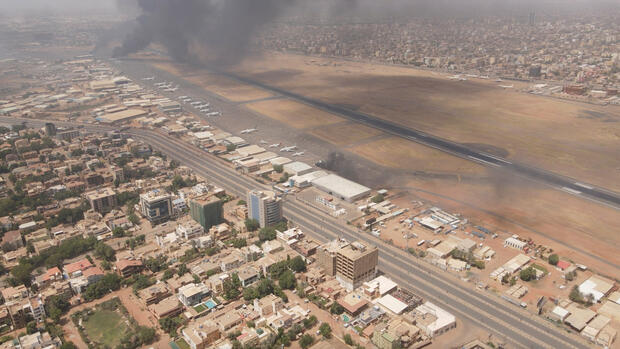Smoke rises above the Sudanese capital.
(Photo: INSTAGRAM @LOSTSHMI via REUTERS)
Khartoum After weeks of tension between ruler General Abdel Fattah al-Burhan and his deputy Mohammed Hamdan Daglo, heavy fighting broke out in Sudan. At least 97 civilians have been killed and 365 others injured since fighting broke out between the army and paramilitary forces in Sudan. This was announced by the Central Committee of Sudanese Doctors early Monday morning.
Since Saturday, the country has been at risk of falling into chaos as a result of fighting between the armed forces and an influential paramilitary force. Who is involved in the fighting in Sudan and why? An overview:
Why is there fighting in the country?
Two major military establishments are facing each other in Sudan. The Sudanese armed forces under ruler General Abdel Fattah al-Burhan and the paramilitary Rapid Support Forces (RSF) under the leadership of his deputy Mohammed Hamdan Daglo. Tensions have been raging between the two military leaders for weeks over the planned integration of the RSF into the Sudanese army.
Who currently controls the country?
It is probably the question of who would receive supreme command of the troops in the future that ultimately led to the violent escalation. Since the fall of long-term ruler Omar al-Bashir in 2019, the army has effectively controlled Sudan, which has a population of around 46 million. So far, this has worked closely with the RSF.
The army may be gaining the upper hand in the fierce fighting. They flew airstrikes on RSF barracks and bases, witnesses and local residents said on Sunday. The army has also regained control of much of the presidential palace in the capital, Khartoum.
Originally, the parties on Sunday agreed to a three-hour lull in fighting to allow for humanitarian evacuations proposed by the United Nations, according to the UN mission in Sudan. However, after a brief period, the agreement was largely ignored.
Who are the RSF?
The RSF formed in 2013 from a conglomerate of former militias in the western state of Darfur. There have been conflicts between the Arab-dominated government and the African ethnic minority in the region for decades. The RSF initially supported the government there and turned out to be a particularly brutal unit. According to Human Rights Watch, the group and its leader Daglo are responsible for human rights abuses such as mass rapes. For years, the RSF worked with the military. The militia is estimated to have tens of thousands of fighters, but the armed forces can score with more heavy weapons and their air force.
What was the political situation in Sudan like before the violence escalated?
Under the long-term ruler Omar al-Bashir, Sudan was recently caught up in a devastating economic crisis. Food and gasoline prices rose dramatically. After mass protests by the population, al-Bashir had to resign from office in 2019 after a military coup. Actually, a two-year transition phase to democratic elections should follow.
However, a civilian government headed by Prime Minister Abdalla Hamdok, which has since been installed and controlled by the military, has not been able to stabilize the country. Al-Burhan canceled it again in 2021. This April, the military government should have again ceded powers to civilian politicians. However, one requirement was that the RSF troops should have been integrated into the Sudanese army. The dispute had again delayed the democratization process.
Dozens of civilians killed in fighting in Sudan
Which foreign powers have influence in Sudan?
Both military leaders can rely on regional allies. According to Rashid Abdi, Sudan expert at the Shahan think tank, which specializes in the Horn of Africa, Ethiopia and Eritrea support Daglo, while Egypt supports al-Burhan. The background is a dispute over a dam project on the Nile in Ethiopia. Egypt is trying to prevent this together with Sudan. The wealthy Saudi Arabia, on the other hand, sees itself as a mediator.
RSF soldiers and fighters are also supporting the Saudi-led military alliance in the war against the Houthi rebels in Yemen. Internationally, Sudan recently came into focus following a visit by Russian Foreign Minister Sergey Lavrov. The Russians are planning a naval base on the Sudanese coast on the Red Sea. This has recently led to tensions with the United States, which is concerned about its influence in the region.
Does former ruler Omar al-Bashir play a role in the conflict?
Omar al-Bashir ruled Sudan for almost 30 years. Although the military finally overthrew the long-term ruler in 2019, al-Bashir’s fall was preceded by mass democratic protests by the population. The 79-year-old was subsequently sentenced to just two years in prison by a Sudanese court for corruption. In addition, al-Bashir has to answer in court for his coup in 1989. In the worst case, he faces the death penalty.
Deputy Chief of Staff Burhan leads the RSF.
(Photo: Reuters)
At the same time, there are still supporters of the old ruler among the population. Islamist groups in particular see the democratization process as being imposed by the West. Most recently, death threats against UN special envoy Volker Perthes were made at a meeting that was reportedly attended by Al-Bashir supporters.
What’s next in Sudan?
It is still unclear which of the two factions will prevail in Sudan. “This was always the nightmare scenario,” says Alan Boswell, Sudan expert at think tank International Crisis Group. A long battle between the Sudanese military and the RSF could fragment the country and destabilize the entire Horn of Africa region.
The international community is therefore urging a speedy end to the violence and negotiations between al-Burhan and Daglo. However, the potential for conflict between them has been blindly ignored for a long time, says Sudan expert Abdi. A transition to a civilian and democratically elected government seems to have receded even further as a result of the fighting.
More: Ongoing fighting in Sudan, struggles for general command and numerous deaths
